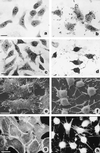Occurrence, diversity, and pathogenicity of halophilic Vibrio spp. and non-O1 Vibrio cholerae from estuarine waters along the Italian Adriatic coast
- PMID: 10347072
- PMCID: PMC91407
- DOI: 10.1128/AEM.65.6.2748-2753.1999
Occurrence, diversity, and pathogenicity of halophilic Vibrio spp. and non-O1 Vibrio cholerae from estuarine waters along the Italian Adriatic coast
Abstract
The occurrence, diversity, and pathogenicity of Vibrio spp. were investigated in two estuaries along the Italian Adriatic coast. Vibrio alginolyticus was the predominant species, followed by Vibrio parahaemolyticus, non-O1 Vibrio cholerae, and Vibrio vulnificus. By using a biochemical fingerprinting method, all isolates were grouped into nine phenotypes with similarity levels of 75 to 97.5%. The production of toxins capable of causing cytoskeleton-dependent changes was detected in a large number of Vibrio strains. These findings indicate a significant presence of potentially pathogenic Vibrio strains along the Adriatic coast.
Figures



References
-
- Alsina M, Blanch A R. A set of keys for biochemical identification of environmental Vibrio species. J Appl Bacteriol. 1994;76:79–85. - PubMed
-
- Alsina M, Blanch A R. Improvement and update of a set of keys for biochemical identification of environmental Vibrio species. J Appl Bacteriol. 1994;77:719–721. - PubMed
-
- Baumann P, Furniss L, Lee J V. Genus I. Vibrio. In: Krieg N R, Holt J G, editors. Bergey’s manual of systematic bacteriology. Baltimore, Md: The Williams & Wilkins Co.; 1984. pp. 518–538.
-
- Blake P A, Weaver R E, Hollis D G. Disease of humans (other than cholera) caused by vibrios. Annu Rev Microbiol. 1980;34:341–367. - PubMed
-
- Bolinches J, Romalde J L, Toranzo A E. Evaluation of selective media for isolation and enumeration of vibrios from estuarine waters. J Microbiol Methods. 1988;8:151–160.
Publication types
MeSH terms
LinkOut - more resources
Full Text Sources
Miscellaneous

